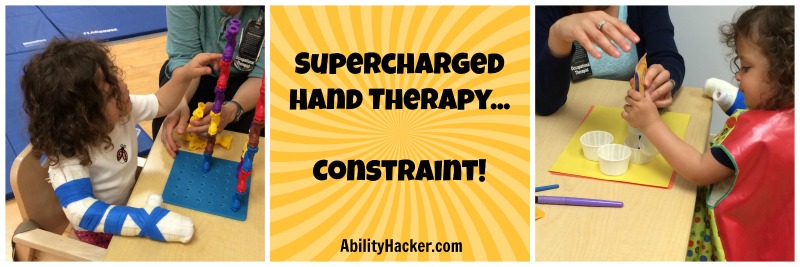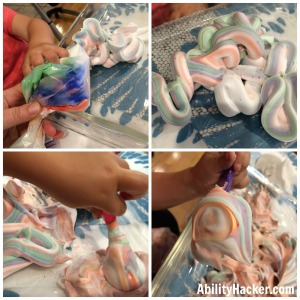 The absolute BEST thing we’ve ever done for Lily’s left hand is constraint therapy. When I first heard the details of the program, it scared me a bit, and made me feel like a meanie to consider doing it to my child. However, when I thought about it in the context of eye patching, which is used to strengthen a weaker eye, it made total sense.
The absolute BEST thing we’ve ever done for Lily’s left hand is constraint therapy. When I first heard the details of the program, it scared me a bit, and made me feel like a meanie to consider doing it to my child. However, when I thought about it in the context of eye patching, which is used to strengthen a weaker eye, it made total sense.
What is constraint therapy?
Constraint therapy basically means that you constrain the hand / arm that has superior function in order to force use of the weaker hand / arm to build strength and dexterity.
When a child is really small, you can constrain the stronger hand with a self-adhesive wrap. We did this when Lily was less than a year old, and it worked well for short periods of play. However, as she got older, she was able to escape the wrap too easily, so the method became less effective.
The more intense version of constraint therapy involves creating a cast for the “good” arm that starts beyond the fingertips and extends past the elbow and up near the shoulder. The child then wears the cast for a certain amount of time per day, restricting their stronger arm and requiring them to use their weaker hand to complete all tasks.
Our first experience with casted constraint therapy: 2 yrs old
There are a variety of options for how to structure this type of therapy. The first time we did the casted version of constraint Lily was just over 2 years old. We were given the following choices:
• 4 weeks option: Wear cast all day, every day (except baths & overnight). Six therapy appointments with OT (1 hour a week + casting appt. + results assessment session)
• 8 weeks option: Wear cast 4 hours per day while engaged in hand activities. Ten therapy appointments with OT (1 hour each week + casting appt. + results assessment session).
I hemmed and hawed quite a lot on this decision because I could see pros and cons to both. I liked the shorter duration of the 4 week option, but worried that having Lily in a cast all day would negatively impact her walking. After all, how was she supposed to use her walker if she can only use one hand? A few hours per day in the cast seemed like a better balance for gross motor development. However, with only a few hours in the cast for a 2 year old, it could be a big fight to simply get the cast on. She could also be stubborn for 4 hours and flat out refuse to use her hand.
When I consulted our physical therapist through early intervention, she made the choice crystal clear. She wasn’t worried about taking a step back on walking. In fact, she felt Lily would surprise us with how well she would be able to get around. She also suggested that having her wear the cast all day would be easier on all of us due to reducing the “fight/stubbornness” dynamic. She was right on all accounts.
Lily did tire of the cast, especially near the end of our 4 weeks. However, it simply became part of our routine. First thing in the morning – choose an overwrap and put on the cast. Last thing before bath at night – take the cast off. Her resilience was impressive. On the very FIRST day, she used her walker without any issue by balancing her casted arm on the handle.
The results we saw with her left hand blew my mind. While she still had a lot of room to improve (and still does), she went from barely being able to open her hand to being able to pick up and stack lightweight objects, and to being able to eat applesauce with a spoon using her left hand. It still took her more effort and concentration to complete these tasks, but it was a huge step forward.
Our second experience with casted constraint therapy: 3 1/2 yrs old
We just kicked off our second experience with casted constraint therapy this past week. Our goal this time is dressing and undressing herself as well as dressing/undressing a doll. Her left hand challenges make these tasks especially difficult for her.
In just a year since we last did constraint therapy, it seems that the thinking has shifted slightly. Instead of 4 and 8 weeks, the options were 3 and 6 weeks. However, the 3 week option (which we are doing) only requires 3 hours a day in the cast instead of all day! After doing some research on different wear times, they have found that wearing the cast for less time is still effective at progressing the weaker hand.
At first, I was SUPER excited about only having the cast on for 3 hours. Only 3 hours? Piece of cake! Or so I thought…
I have a confession to make: I am a rule follower.
The rules of the therapy state that she must actively use her left hand while the cast is on. The entire time. Because of this, I am SO STRESSED about making sure her left hand is occupied during those three hours! Toss her stubborn streak into the mix, her recent affinity for whining, the poor timing of my husband being taken to his knees by a powerful daycare sickness, and a few projects at work all due during this 3 week period… I’m a wreck. A complete wreck.
However, we can already see progress. After less than a week, she can put her shirt on and take it off with very little help, and she is using her left hand more even when the cast is off. Also, my husband is emerging from his sick stupor. Things are looking up!
This therapy is not for the faint of heart, but it WORKS.
Lessons learned & what I’d recommend if you try constraint therapy
- Pick a time period where things in your life are otherwise pretty calm.
- On day one, forgive yourself for not being able to perfectly execute this therapy every day for the entire time (my husband made me do this today after my mini breakdown). It’s hard. Do the very best you can, and realize you’re still making more progress than if you didn’t do the therapy at all.
- If your child is old enough and able to understand, talk to them about why you are doing the therapy. We’ve explained to Lily that we are casting righty to help lefty get stronger. We’ve asked her how she feels about it, and talked to her about how hard and frustrating it is for her. We’ve told her that we are so proud of her for how hard she is working even though she doesn’t like having her right hand in a cast. We reiterate how proud we are often. It seems to help.
- Get your child to bed on time. This therapy seems to EXHAUST her, and on days when she is overtired, I nearly lose my mind.
- Get yourself to bed on time.
 Similar reasons to above, except it’s you that will be exhausted.
Similar reasons to above, except it’s you that will be exhausted. - Ask for different colored over wraps for the cast & let your child pick their color each day. Our OT has even given us some wraps with shapes on them (hearts, dinosaurs, stars). Lily doesn’t get a choice on whether to put the cast on, but she does get to choose the color, which gives her some level of control.
Ideas for one handed activities to do while the cast is on:
- Simple wooden peg puzzles (the kind that have shaped pieces that fit into an indented area on the puzzle board – Melissa & Doug makes them).
- Latches-board (i undo the latches on ours and ask her to open and close the wooden doors to reveal what is underneath)
 Shaving cream – Option 1: Spray it on the table or in a big flat dish (outside or in an easy to clean area) and use a hand to spread it around. Then, use fingers to draw in the shaving cream. Option 2: (we did this today, and it was a huge hit!) Spray the shaving cream into a ziplock bag and add a few squeezes of finger paint. Squish the shaving cream and the paint together in the bag, then snip the corner. Use hand (with you helping) to squeeze the rainbow of shaving cream into a long shallow pan. Then, use a spoon or the hand to scoop and stir the shaving cream around.
Shaving cream – Option 1: Spray it on the table or in a big flat dish (outside or in an easy to clean area) and use a hand to spread it around. Then, use fingers to draw in the shaving cream. Option 2: (we did this today, and it was a huge hit!) Spray the shaving cream into a ziplock bag and add a few squeezes of finger paint. Squish the shaving cream and the paint together in the bag, then snip the corner. Use hand (with you helping) to squeeze the rainbow of shaving cream into a long shallow pan. Then, use a spoon or the hand to scoop and stir the shaving cream around.- Stack blocks in a tower.
- Eat with fingers or a fork. I cut food up for her so that it is already in bite sized pieces. This is always part of our 3 hours in the cast.
- Drumming. We have a little play drum, but a spoon and pot would work just as well.
- Play iPad games. Yesterday, we got in some cast therapy time in the car on the way to a BBQ by setting Lily up with an iPad game in the back seat. It was FABULOUS to be able to drive while chipping away at our 3 hours.
- Drawing, stamping, & other art projects. At therapy yesterday we did stamping with a pencil eraser (push eraser into ink pad, tap on paper to make a dot). Drawing in a spiral notebook is an art activity we’ve done in the car. One day, we made thank you cards for her teachers for the last day of school (I started stickers and held the paper backing while she peeled and stuck them, she drew with markers, etc.). Whatever crafty thing your child is into can likely be done one-handed.
- Blow bubbles. I’m a big fan of the non-spill bubble containers, especially with this type of therapy. Both parts of bubble play are great – dipping the wand and blowing bubbles or popping the bubbles another person blows.
- Hammering. Using a hammer to hit a peg requires holding an object, swinging, and strength to move the peg down.
- Sorting objects. Lily’s therapist had her sort small plastic bears into “bathtubs” (i.e. the segments of an ice cube tray) at our last appointment. I thought that was brilliant!
- Helping open, close, stir, etc. Many of the above activities require opening and closing containers. You can ask your child to help you throughout the activity (during setup, during the activity, and during clean-up).
Have you done constraint therapy? Are you considering it? What questions or tips do you have to share?